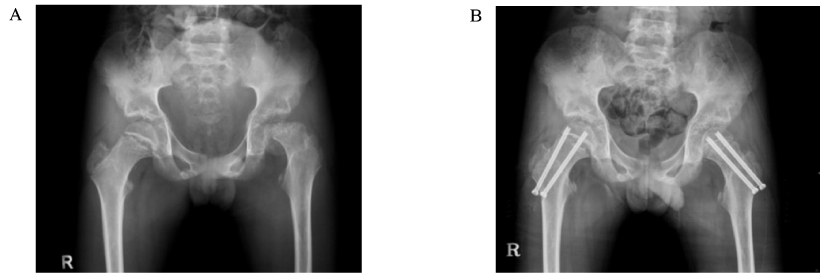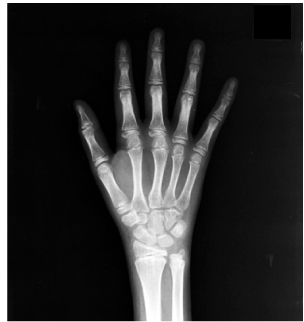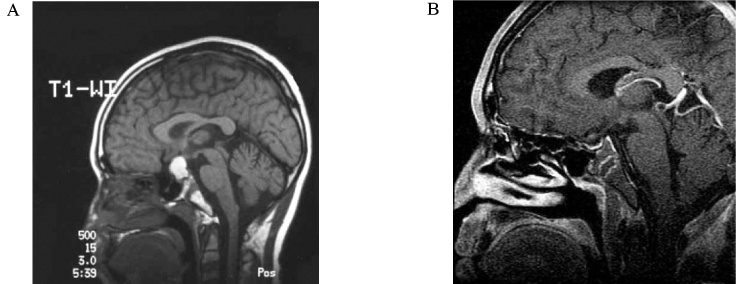J Korean Endocr Soc.
2008 Jun;23(3):193-198. 10.3803/jkes.2008.23.3.193.
A Case of Slipped Capital Femoral Epiphysis in Association with Panhypopituitarism after Treatment of Craniopharyngioma
- Affiliations
-
- 1Department of Internal Medicine, Chonnam National University Medical School, Korea.
- KMID: 1479206
- DOI: http://doi.org/10.3803/jkes.2008.23.3.193
Abstract
- Craniopharyngioma accounts for 2~5% of all primary intracranial neoplasms. It may present with a variety of manifestations including neurological, visual, and/or hypothalamic-pituitary dysfunction. Treatment options include radical surgery or radiotherapy, or a combination of these modalities. Craniopharyngioma ablation results in anterior and/or posterior pituitary hormone deficits. Slipped capital femoral epiphysis (SCFE), in which the femoral head slips downward and backward on the femoral neck at the epiphyseal plate, most commonly occurs during the rapid growth phase of puberty. Its actual cause is unknown, but the clinical association between SCFE and endocrine disorders is well known. We report a case of an adult male patient who developed SCFE in association with panhypopituitarism after treatment of a craniopharyngioma.
Keyword
MeSH Terms
Figure
Reference
-
1. Karavitaki N, Cudlip S, Adams CB, Wass JA. Craniopharyngiomas. Endocr Rev. 2006. 27:371–397.2. Chung JH, Lee HC, Yoo NC, Chung YS, Lim SK, Kim KR, Huh KB. Clinical aspects on craniopharyngioma. J Kor Soc Endocrinol. 1991. 6:163–169.3. Paja M, Lucas T, García-Uría J, Salamé F, Barceló B, Estrada J. Hypothalamic-pituitary dysfunction in patients with craniopharyngioma. Clin Endocrinol (Oxf). 1995. 42:467–473.4. Karavitaki N, Brufani C, Warner JT, Adams CB, Richards P, Ansorge O, Shine B, Turner HE, Wass JA. Craniopharyngiomas in children and adults: systematic analysis of 121 cases with long-term follow-up. Clin Endocrinol (Oxf). 2005. 62:397–409.5. Loder RT, Wittenberg B, DeSilva G. Slipped capital femoral epiphysis associated with endocrine disorders. J Pediatr Orthop. 1995. 15:349–356.6. Harris WR. The endocrine basis of slipping of the upper femoral epiphysis. An experimental study. J Bone and Joint Surg. 1950. 32:5.7. Blethen SL, Rundle AC. Slipped capital femoral epiphysis in children treated with growth hormone. A summary of the National Cooperative Growth Study experience. Horm Res. 1996. 46:113–116.8. Jeon HJ, Ko BS, Kim DH, Bae JH, Oh TG, Kang SB. Kallmann's syndrome associated with slipped capital femoral epiphysis. J Kor Soc Endocrinol. 1996. 11:318–323.9. Wilcox PG, Weiner DS, Leighley B. Maturation factors in slipped capital femoral epiphysis. J Pediatr Orthop. 1988. 8:196–200.10. Rappaport EB, Fife D. Slipped capital femoral epiphysis in growth hormone-deficient patients. Am J Dis Child. 1985. 139:396–399.11. Ippolito E, Mickelson MR, Ponseti IV. A histochemical study of slipped capital femoral epiphysis. J Bone Joint Surg Am. 1981. 63:1109–1113.12. Hochberg Z. Clinical physiology and pathology of the growth plate. Best Pract Res Clin Endocrinol Metab. 2002. 16:399–419.13. Alini M, Kofsky Y, Wu W, Pidoux I, Poole AR. In serum-free culture thyroid hormones can induce full expression of chondrocyte hypertrophy leading to matrix calcification. J Bone Miner Res. 1996. 11:105–113.14. Dearden LC. Enhanced mineralization of the tibial epiphyseal plate in the rat following propylthiouracil treatment: a histochemical, light, and electron microscopic study. Anat Rec. 1974. 178:671–689.15. Weise M, De-Levi S, Barnes KM, Gafni RI, Abad V, Baron J. Effects of estrogen on growth plate senescence and epiphyseal fusion. Proc Natl Acad Sci U S A. 2001. 98:6871–6876.16. Isaksson OG, Lindahl A, Nilsson A, Isgaard J. Mechanism of the stimulatory effect of growth hormone on longitudinal bone growth. Endocr Rev. 1987. 8:426–438.17. Wells D, King JD, Roe TF, Kaufman FR. Review of slipped capital femoral epiphysis associated with endocrine disease. J Pediatr Orthop. 1993. 13:610–614.18. Hägglund G, Hansson LI, Ordeberg G, Sandström S. Bilaterality in slipped upper femoral epiphysis. J Bone Joint Surg Br. 1988. 70:179–181.19. Bunin GR, Surawicz TS, Witman PA, Preston-Martin S, Davis F, Bruner JM. The descriptive epidemiology of craniopharyngioma. J Neurosurg. 1998. 89:547–551.20. Van Effenterre R, Boch AL. Craniopharyngioma in adults and children: a study of 122 surgical cases. J Neurosurg. 2002. 97:3–11.
- Full Text Links
- Actions
-
Cited
- CITED
-
- Close
- Share
- Similar articles
-
- A Case of Panhypopituitarism Due to Craniopharyngioma with Slipped Capitalis Femoral Epiphysis
- Panhypopituitarism due to craniopharyngioma with bilateral slipped capital femoral epiphysis
- A Clinical Study of Slipped Capital Femoral epiphysis
- Pathologic Separation of Capital Femoral Epiphysis due to an Osteosarcoma
- Prognostic Factors in Slipped Capital Femoral Epiphysis





